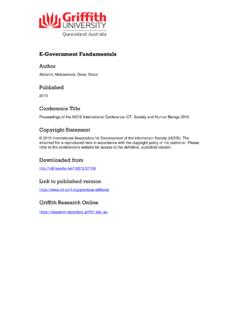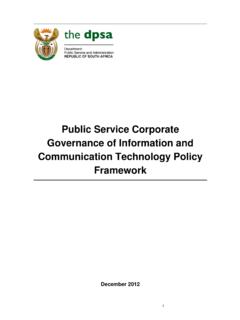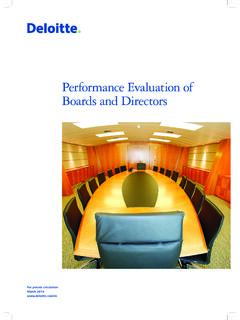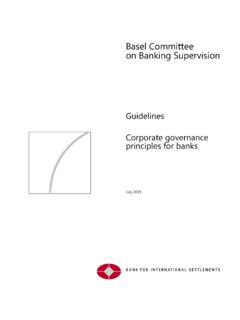Transcription of 2. Good governance – the concept
1 2. good governance the conceptIn the last twenty years, the concepts of governance and good governance have become widely used in both the academic and donor communities. These two traditions have dissimilar conceptualisations. First, there is the academic approach, which focuses mainly on the study of the different ways in which power and authority relations are structured in a given society. Second, there is the donor community s approach, which puts emphasis on the role state structures play in ensuring social, economic and policy equity and accountability through open policy o o d G o v e r n a n c e i n M u l t i e t h n i c C o m m u n i t i e s12 According to the academic approach, the generic understanding of governance is the management of resources and policy-making by means of exer-cising authority (power). Thus, it entails all ins-truments through which different policy stake-holders exercise legal rights with the aim to achieve political, economic, cultural and social objectives.
2 In this sense, the term governance appears to be more and more used in order to de-note a complex set of structures and processes (at the public as well as at the private level), which are generally associated with national administration. However, its definitions offer a rather broad hori-zon of interpretation: wherever we can find this term, its definition varies slightly. For instance, in the Report of the Commission on Global governance Our Global Neighbourhood (1995) governance is defined as: good governance is a normative conception of the values according to which the act of governance is realized, and the method by which groups of social actors interact in a cer-tain social context. The lack of a generally ac-cepted definition of the concept is compensa-ted by the identification of principles that strengthen good governance in any society. The most often enlisted principles include: partici-pation, rule of law, transparency of decision-making or openness, accountability, predicta-bility or coherence, and effectiveness.
3 The international donor community generally sha-res the view that these principles stand at the foundation of sustainable development. The first characteristic refers to equal participa-tion by all members of society as the key ele-ment of good governance , with everyone having a role in the process of decision-making. Second-ly, good governance implies the rule of law maintained through the impartiality and effec-tiveness of the legal system. Rule of law also means the protection of human rights (particu-larly those of minorities), independent judiciary and impartial and incorruptible law enforce-ment agencies. The rule of law involves a variety of conditions, being strongly connected to good administration of justice, good legal framework, verified dispute mechanisms, equal access to justice, and the independence of judiciary workers (lawyers, judges). good governance is also based on the transpa-rency of the decision-making process, which ensures that information is freely available and accessible to those involved or affected by the decisions taken.
4 Transparency therefore means free access to information. Last, but not least, accountability and responsibility (of the insti-tutions, just as much as of the civil society) are key requirements of good governance , with all of the participants in the political and econo-mic processes being accountable for their deci-sions to each other. The sum of the many ways individuals and institu-tions, public and private, manage their common affairs. It is a continuing process through which conflicting or diverse interests may be accommoda-ted and co-operative action may be taken. It inclu-des formal institutions and regimes empowered to enforce compliance, as well as informal arrange-ments that people and institutions either have agreed to or perceive to be in their is good governance ? Report of the Commission on Global governance Our Global Neighbourhood o o d G o v e r n a n c e - t h e C o n c e p t13 The concept of good governance emerged mainly because practices of bad governance , characteri-zed by corruption, unaccountable governments and lack of respect for human rights, had become increasingly dangerous, and the need to intervene in such cases had become urgent.
5 good gover-nance has become an important element of the political and economic agendas, and has meanwhi-le been better specified along with the prolifera-tion of good practices that take the concept into consideration. Beyond entailing just multiparty elections, a judiciary and a parliament, which have been identified as primary components of Western-style democracies, good governance goes on to address several other central issues: The development of the protection of human rights; non-discri-minatory laws; efficient, impartial and rapid judi-cial processes; transparent public agencies; accoun-tability for decisions by public officials, devolution of resources and decision making to local levels from the capital; and meaningful participation by citi-zens in debating public policies and A question of critical importance is how far can the concept actually go? The answer to this question can be found in practice rather than just in theory; although the focus is on the public sector, where capacity building is called upon in order to strengthen and develop the social and economic situation, the concept applies to the private sector and the civil society, as well.
6 When talking about good governance , what is generally referred to is the ability to perform efficiently, effectively and responsively, guided by principles that are feasible and desirable at all levels of the society, not just at the political one. As noticed in research material, reports and studies on the subject, good governan-ce is a notion that refers to, and is functional in, a number of domains, going from institutional development to non-state actors involvement. The principle of good governance covers different ideals for a better society. First of all, there s a technical dimension of the concept , which refers to the economic aspect of governance , namely the transparency of government accounts, the effecti-veness of public resources management, and the stability of the regulatory environment for private sector activity 3. Secondly, the social dimension, to build, strengthen and promote democratic institutions as well as tolerance throughout so-ciety.
7 4 And thirdly, the political dimension refers to the legitimacy of government, the accountabi-lity of the political elements of government and respect for human rights and the rule of law. 5 When it comes to participation, equity, inclusive-ness, or transparency, minorities need a specific approach with regard to good governance strate-2. Miriam Wyman - Thinking about governance : A Draft Discussion Paper Prepared for The Commonwealth Foundation Citizens and governance Programme- 3. The Foreign and Commonwealth Office 4/5. The Foreign and Commonwealth concept , a var iet y of o o d G o v e r n a n c e i n M u l t i e t h n i c C o m m u n i t i e s1 gies in terms of their relationship to the major stakeholders, since their position in the society is most often fragile and too minor . When talking of minority issues and their involvement in the process of good governance , another subject comes to mind and is best exemplified in the Balkans: the application of good governance prin-ciples in post-conflict and divided societies, a subject that since the 1990 s has continuously been on the international political agenda.
8 The principles of good governance are effective in post-conflict and divided societies as a neutral and practical set of measures meant to advance the rebuil-ding of the nations and to re-set a vital connection between the civil society and the state institutions. The reason why the basic principles of good gover-nance are called upon in this case is that it supposes the re-establishment of security and prosperity for all people, while managing the development of the state during the transition period. The main challenges of the post-conflict societies refer to the process of constructing a democracy while surpassing the period of chaotic and precarious transition. The reason why the Balkans are an even more dif-ficult and challenging subject for the supporters of the good governance principles is that the societies involved in this process need to cope not just with the institutional problems (lack of legitimate authority, a gap in the political tradition, etc.)
9 , but also with the social problems resulting from the internal conflicts between different ethnicities. Thus, the principles of good governance practices need to ensure the development of cooperative relationship not only among different institutions, but also among different social groups. This com-munication among different actors and the partici-pation of all in the governance process is an impor-tant prerequisite to cultivate the values that foster the respect for ethnic diversity, support multicultu-ral communication and the collaboration between representatives of different ethnic groups. Establishing a democratic system that builds on the structures of good governance principles is not an easy task, and has to take into account a number of complex issues that make every situation unique and in need of specific measures: the way the conflict was settled, the extent to which statehood had been destroyed or altered, and most important, the quan-tity of international support that contributes to the development of these countries.
10 All of this has to be taken into account when strategies are proposed, in order to succeed in re-establishing peace and strengthening local and national capacities, together with the specificities of the area (mainly multi-eth-nic cultures), and managed through cooperation and respect for good governance principles. After identifying the general configuration of re-building a post-conflict society on good governance architecture, the concrete measures can be operatio-nalised by placing them into three different dimen-sions of governance , as identified by Tobias Debiel and Ulf Terlinden: security, politics/administration and economy. 6 The first and probably the most important prerequi-site of good governance is security governance , which assures a framework for the application of all other conditions. Security problems appear in all post-conflict societies, as do problems such as lack of authority, inability of the legal institutions to control crime, erosion of the judiciary system, or use of force (by both the legally established and the underground organizations).










